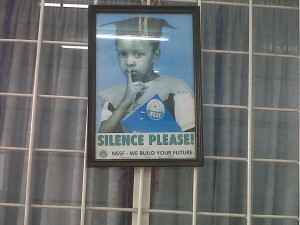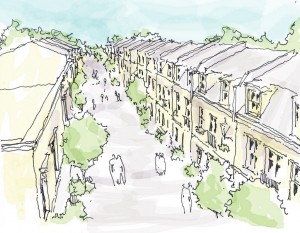
Audio landscapes along with imagery help visualize the local context of a design project.
I am in the midst of a course on mobile learning management and I thought that one of the solutions (assignments) that I submitted for the course might be applicable to others out there so here you have it. Basically this involves developing an augmented reality design scenario for students. The background task (which I chose) was to develop learning centers for a hybrid university predominantly existing online, but with regional leaning centers scaled throughout the country in question. Each regional learning center should be contextual to the location in question, yet maintain branded elements (and an overall branded aesthetic) of the overall university. A challenging micro/macro project, for sure, but one that can be accomplished, I think, through some off-the shelf augmented reality technology, a mobile phone or tablet with a microphone, camera, and video recording capabilities, and some sketching application.
Design an augmented reality (AR) scenario
In keeping with the provided example of using AR technology to improve school design to reflect modern educational practices and contextual concerns, I look to a similar example at a new hybrid university with both online and face to face components. In this example, the university is attempting to place the majority of the instructional and reflective activity online while developing face to face models that stress collaboration, consultation, and overall networking. So students perform the vast majority of their work online while meeting at regular intervals face to face at centers scattered throughout the country to foster collaboration, consultation (how accurate is the students’ work), and community building and ideally spurring further reflection.
As such these centers would be designed not to reflect 20th century educational practices, but serve as community centers where students rally around their academic community. Therefore, it is imperative that each center be highly contextual to the surrounding environment. It needs to be inviting, socially designed, capable of performing the educational tasks it has been assigned, and aware of its surrounding sensory elements (audio, imagery, urban vs. rural, ambient elements). AR technology could exist in this design and further it could be a collaborative student/designer-driven learning experiment.

Task
- Design team interviews proposed students and faculty to determine needs for centers. In these interviews, students are asked about their studying process and workflows.
- Overall team compiles needs and develops outline of proposed design and models this using Google Sketchup. These outline designs are to be kept visually to basic designs reflecting required functions of the academic community working in them. These designs are made available using mobile technology (using AutoCAD, Google, http://www.3don.co.uk/ or a similar service)
- Three teams travel to three proposed location centers (one each) in City A, City B, City C, all three large urban centers with dramatically different demographics (in terms of cultural influence, climate, religious or ethnic composition, etc.). Teams explore proposed site, capture multimedia of the location. This multimedia would include the following:
- audio: recording ambient sounds from each corner of the proposed site and the major approaches (to simulate student approaches to the center)
- video: recording the approaches and the site itself (specifically surrounding buildings)
- imagery: teams record local signs, colors, buildings, vegetation, and roads
- audio from interviews with local shopkeepers, police officers, citizens to determine their understanding of what the center will be
- Additionally, design teams research historical imagery from the location and upload that to Historypin (or Wikitude or Layar) to present the historical evolution of the location.
- Using AR applications (such as Wikitude or Layar), design teams adjust proposed design to fit local contextual environment.
- Teams compile their adjusted design and multimedia captures into one large 3D contextual cityscape/sitescape presenting the proposed center as a product of its contextual surroundings. This is presented to the overall design team and the new design is justified as a product of these particular contextual elements.
- To test the accuracy of the newly proposed design, teams rotate to a different location and use the AR to visualize the audio, imagery, and video of the proposed location in comparison to what they see and what is being proposed in the design.
- Overall team extracts pattern language (design patterns) from these different designs and uses this pattern language to inform the branding of the individual centers. This branding should organically emerge from the contextual elements of each center.

